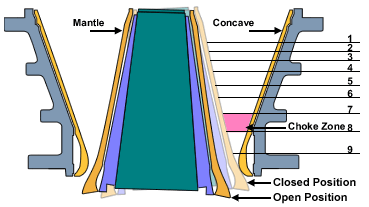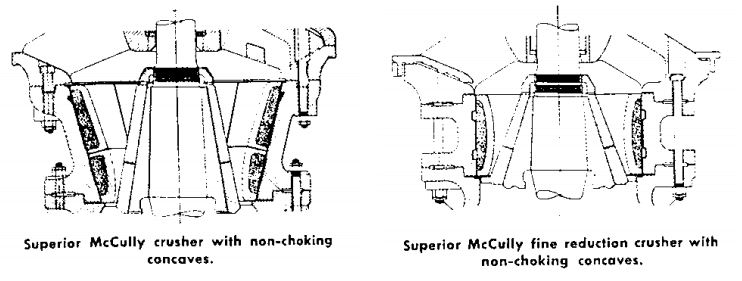 We all understand how choke feeding a crusher makes for good operation and product size but operators need to also know How to Prevent and avoid that same Crusher from Choking. It is apparent that although the distance between successive horizontal planes increases gradually as these planes move downward (due to increased throw of the head), the areas, and hence the volumes, successively decrease. If we conceive the volume 0-1 as consisting of a mixture of rock and air that is, containing a certain percentage of voids, then it is evident that when this volume has moved to position 9, the percentage of these voids will be considerably diminished. If it should happen that the voids have reached such a low proportion when the material drops from 7-8 to 9, that the closing stroke on 9 completely eliminates all voids, we have a choked condition at that point, a condition which is untenable because downward movement of the material ceases, and the crusher either stalls or fails at some point.
We all understand how choke feeding a crusher makes for good operation and product size but operators need to also know How to Prevent and avoid that same Crusher from Choking. It is apparent that although the distance between successive horizontal planes increases gradually as these planes move downward (due to increased throw of the head), the areas, and hence the volumes, successively decrease. If we conceive the volume 0-1 as consisting of a mixture of rock and air that is, containing a certain percentage of voids, then it is evident that when this volume has moved to position 9, the percentage of these voids will be considerably diminished. If it should happen that the voids have reached such a low proportion when the material drops from 7-8 to 9, that the closing stroke on 9 completely eliminates all voids, we have a choked condition at that point, a condition which is untenable because downward movement of the material ceases, and the crusher either stalls or fails at some point.
There must be a maximum safe ratio between the volumes 0-1 and 9, a ratio which must depend upon the shape of the crushing chamber, the amount of head-movement, the percentage of voids in the feed, and upon the character of the feed, with particular reference to the manner in which it shatters in the crusher. The more fines there are in the feed, the less will be the percentage of voids, and the greater will be the chance of building up to a choked condition. This is especially true for high reduction ratios and close discharge settings; it is the reason why the careful crusher builder always cautions against feeding unscreened material to fine-reduction crushers. It is also understandable why it is advisable to use reduced throw eccentrics for settings below the manufacturer’s recommended minimums. If a condition of near-choke should exist just above the discharge level, a large movement of the head may be sufficient to complete the choke; whereas a smaller throw would not be so likely to “follow through” to that extent. It is apparent that the choke-point in the crushing chamber we have been discussing is at the discharge level, or immediately above it. It is equally clear that the unit pressures in such a chamber increase progressively from the top, down, reaching their maximum value at the choke-point, where the voids are at a minimum. It follows that the amount of wear on head and concaves must increase progressively toward the lower part of the chamber. As a matter of fact, when the crusher setting and other conditions are such that the machine is operating at anything approaching a choke condition, wear is very rapid in the region of the discharge point, as compared to the rest of the chamber so much so that “belling” of the head, and “dishing” of the concaves is likely to progress to a troublesome degree.
It is apparent that the choke-point in the crushing chamber we have been discussing is at the discharge level, or immediately above it. It is equally clear that the unit pressures in such a chamber increase progressively from the top, down, reaching their maximum value at the choke-point, where the voids are at a minimum. It follows that the amount of wear on head and concaves must increase progressively toward the lower part of the chamber. As a matter of fact, when the crusher setting and other conditions are such that the machine is operating at anything approaching a choke condition, wear is very rapid in the region of the discharge point, as compared to the rest of the chamber so much so that “belling” of the head, and “dishing” of the concaves is likely to progress to a troublesome degree.
https://www.911metallurgist.com/crusher-working-principle
